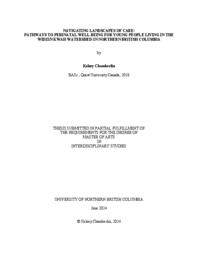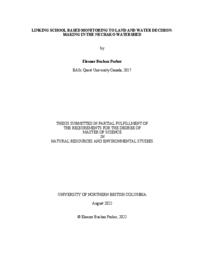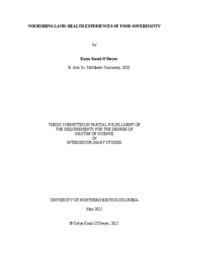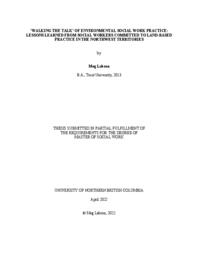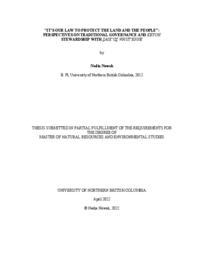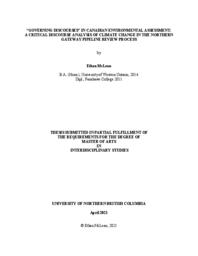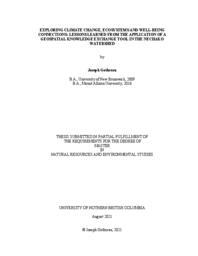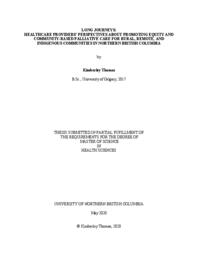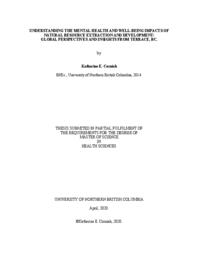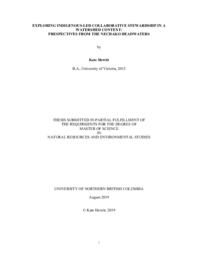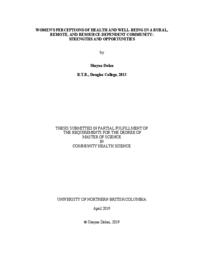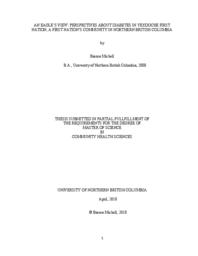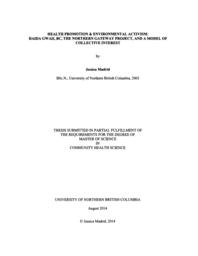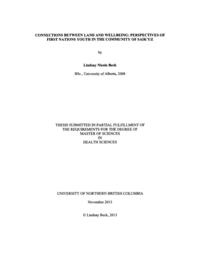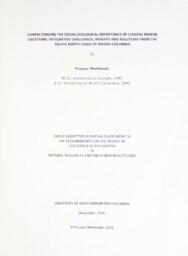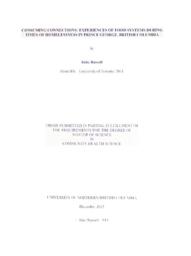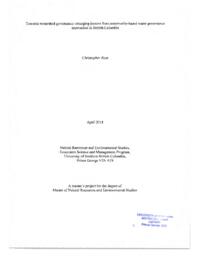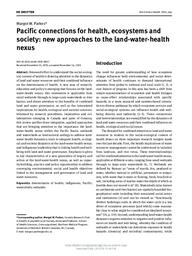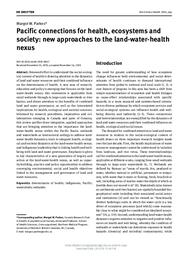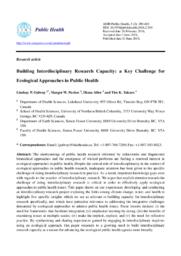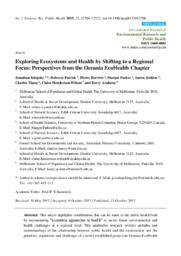Parkes, Margot
Person Preferred Name
Margot Parkes
Related Works
Content type
Digital Document
Origin Information
Content type
Digital Document
Description / Synopsis
Scholars have been calling for the integration of the natural environment within social work for over thirty years. However, the literature provides little insight into youth perspectives on their relationships with land and place, particularly in rural and remote communities. In fall 2022, I interviewed twelve students ages 14-17 at Fort St James Secondary School in BC’s Nechako Lakes District (School District 91) about their experiences spending time outdoors. By student choice, half of these interviews took place inside their school and half took place in outdoor settings nearby the school. Through reflexive thematic analysis, I developed five themes from our interviews, including (1) Specificity in relationships: Where we are (and who we are) matters; (2) Pathways to negotiating relationships with land and place; (3) Intersections of community, land, and youth resilience; (4) People are connected through place and time; and (5) Youth have agency and responsibility. My discussion links youth relationships with land and place to social work practice and highlights connections between the resilience of youth, their communities, and the land and water they rely on. This research contributes to a growing body of literature on social work and the environment and identifies future avenues for the integration of land and place within research.
Origin Information
Content type
Digital Document
Description / Synopsis
Climate change is compounding existing threats to waters from land use activities such as forestry, agriculture, and mining, requiring alternative approaches to caring for watersheds. Community science and school-based monitoring are gaining attention as processes for communities and youth to become involved in decision-making by collecting data about the health of their lands and waters. However, due to the complexity of social-ecological systems, connecting community science to decision-making is a recognized challenge requiring more qualitative research that engages various actors. In response, this action-research project aimed to co-design water monitoring tools with students, teachers, and decision-makers to explore potential avenues for school-based monitoring to inform decision-making. The project focused on the case study of the “Koh-learning in our Watersheds” education initiative on Saik’uz First Nation Territory near Vanderhoof, British Columbia. Research activities took place with high-school classes from the Nechako Valley Secondary School at locations along Murray Creek, a tributary to the Nechako River. Phases of water monitoring actively shaped and informed qualitative research interviews and workshops to bring together youth, teachers, and decision-makers. Pathways identified for school-based monitoring to inform decision-making include: 1) increased attention on waterways, 2) identifying issues and imagining solutions, 3) filling gaps and providing new data, 4) behaviour change and stewardship, 5) contributing to reconciliation, and 6) conversations for action. The findings highlight that the strengths of school-based monitoring lie in its ability to contribute imaginative solutions to local problems that perplex decisionmakers and, when attuned to and aligned with Indigenous governance, can meaningfully support truth and reconciliation. Informed by these findings, an adapted version of the framework for a ‘social learning approach to monitoring’ is proposed and may serve as a tool in the design of future school-based monitoring that can target multiple pathways to influence decision-making. This research underscores that when connecting across knowledges, generations, and linking with decision-making, school-based monitoring can support a paradigm shift in water management.
Origin Information
Content type
Digital Document
Description / Synopsis
Indigenous food sovereignty— a living reality prior to colonization, which violently disrupted Indigenous food systems—is characterized by Indigenous peoples’ self-determination in controlling their food systems and culturally informed foods practices. Directly related to ongoing coloniality, food insecurity is central to the disproportionately high burdens of poor health affecting Indigenous peoples. By exploring the health-related experiences of food sovereignty and Indigenous food sovereignty leaders living in northern BC, this project asks both: How does engaging in food sovereign practices affect peoples’ health? What are the factors that foster (or limit) food sovereignty practices? Being sensitive to past and ongoing colonial and paternalistic research approaches, this research enacts a community-informed ethos, anchored in community-based participatory research (CBPR) processes, wherein research is conducted with and for those involved. This research draws on qualitative methods, including semi-structured (virtual) interviews with community members and knowledge holders, including diverse food sovereignty and Indigenous food sovereignty champions. Champions are involved in various capacities, including direction of research design, engaging in interviews, and informing research outputs. Addressing gaps in the literature, this research documents holistic health experiences of food sovereignty and Indigenous food sovereignty leaders in northern BC. By highlighting experiences faced by those enacting food sovereignty practices, this research offers a counterview to existing bodies of food and health-related research and literature that rely predominantly on quantitative food security metrics. This project’s findings contribute to a growing body of scholarship documenting food sovereignty praxis: the work thus has the potential to inform policy that helps to support the resilience and self-determination of those doing food sovereignty and Indigenous food sovereignty.
Origin Information
Content type
Digital Document
Description / Synopsis
The research presented in this thesis explored environmental social work; in particular, it responds to a gap in the literature regarding the lack of a clear practice model for social workers to follow, by focusing on how environmental social work is done. In order to offer an in-depth, qualitative look at what environmental social work can look like in practice and in specific places, I looked to self-identified social workers living and working in the Northwest Territories (NWT), Canada. The six social workers who responded to this call are all working in ways that integrate land, place, and the physical environment into their social work practice. Due to the impacts of the Covid-19 pandemic, the research was conducted entirely via distance using telephone, e-mail, and Zoom. Using a critical place inquiry approach and framed by theories of ecosystem approaches to health, grounded normativity, and relational validity, six in-depth interviews were conducted with social workers who shared their experiences of land-based practice in their personal and professional lives. Findings took the shape of five themes: ‘Lessons from the Land’, ‘Lessons in Ways of Being for Social Workers’, ‘Lessons from Being in Relationship’, ‘Lessons for our Workplaces and Profession’, and ‘Lessons in Practice’. The findings offer insight and practical examples for social workers seeking to connect their practice to the land; they also contribute practice wisdom to emerging discussions regarding both what can be done in environmental social work practice and how.
Origin Information
Content type
Digital Document
Description / Synopsis
The traditional governance system of S̲aik’uz̲ Whut’enne is rooted in a deep relationship with their Keyoh – their homelands that sustain all life, including the waters, rocks, mountains, plants and animals. Based in S̲aik’uz̲’s inherent Rights and Title, as well as the legal and political context of the United Nations Declaration on the Rights of Indigenous Peoples and evolving Aboriginal case law, this research explores the key institutions and principles of S̲aik’uz̲ traditional governance. Alongside this, it challenges the ways that colonization has disrupted and eroded S̲aik’uz̲ traditional governance through its attempt to remove S̲aik’uz̲ Whut’enne from their Keyoh, impose a colonial Western system of land management, and outlaw their governance system, the Balhats. Informed by decolonizing and Indigenous methodologies, this research has been developed and carried out in collaboration with the S̲aik’uz̲ First Nation and uses qualitative methods including archive and document review, semi-structured interviews, and group review meetings. It offers insights about the persistence of S̲aik’uz̲ Whut’enne against colonial forces, and the ways that S̲aik’uz̲ traditional governance is alive, evolving across time, and of utmost relevance to the present and future.
Origin Information
Content type
Digital Document
Description / Synopsis
This qualitative inquiry focuses on Canada’s environmental assessment (EA) of the controversial—now defunct—Enbridge Northern Gateway Pipeline as a case study. Adapting Fairclough’s (1992) approach to critical discourse analysis (CDA) as a methodological framework, I investigated how Northern Gateway’s environmental effects were discursively framed and rationalized in relation to climate change, and how these discourses are connected to statutory interpretations and institutional norms. Using frame analysis and argumentation analysis as methods, I examined a corpus of publicly available Joint Review Panel (JRP) documents, federal statutes and official decision statements related to Northern Gateway’s EA. Findings suggest that the convergence of particular discourses, ideologies, institutional power relations, and entrenched discretionary practices tended to marginalize and depoliticize climate change considerations in Northern Gateway’s EA. These dynamics provided a foundation to rhetorically legitimate contentious project-related governance decisions, and arguably expose areas of potential concern in the contemporary EA and climate change context.
Origin Information
Content type
Digital Document
Description / Synopsis
The Nechako Watershed is a large system in northern BC that exemplifies the challenge of integrating information across climate, environment and well-being. This research responded to this need with the goal of enhancing how information about the Nechako Watershed is communicated and shared. Informed by the development of a geospatial ‘portal’ tool in northern BC, this research sought to establish the Integrated Watershed Research Group (IWRG) Portal, gain insight on establishing accessible knowledge exchange strategies, and identify its perceived benefits and limitations. The research had two phases. Phase I involved working with a development team to understand this tool, testing, establishing the IWRG Portal, finding and formatting content. Phase II brought members of the Portal User Research Group together to further refine the IWRG Portal and content through scoping discussions, workshops, and a focus group. Thematic analysis was used to code and analyze the transcribed focus group. The research identified benefits of the portal with how it dealt with complexity and its integrative features. Limitations were also found, including the need for intentional framing of data, a steep learning curve, and the need for an internet connection. Analysis also identified the need to tailor content for specific audiences. The research has shown that tools such as the IWRG Portal can create new pathways to understanding and finding information. The research has also identified paths for further refinement and development of the portal tool by expanding the user base and continuing to evaluate the effectiveness of this tool in various contexts.
Origin Information
Content type
Digital Document
Description / Synopsis
Inequitable access to palliative care in Canada is a pressing issue. People with life-limiting illnesses in rural and remote northern and Indigenous geographies in British Columbia (BC) face ethically problematic barriers to receiving palliative care. Palliative approaches that are equity-oriented and community-based bring significant improvements to the healthcare system and to people's quality of life. The purpose of this qualitative study was to find ways to promote health equity and community-based palliative care. This research is informed by action-oriented, anti-colonial, and critical Indigenous methodologies. As perspectives of frontline healthcare workers offer transformative insights, palliative care providers working in northern BC were interviewed, and, from their interviews, three main themes emerged. These were (1) Support Primary Palliative Care, (2) earlier and inclusive Integration of Palliative care, and (3) Culturally Safe Palliative Care. The implications of these findings are situated at the intersection of cultural safety, public health, and health promotion.
Origin Information
Content type
Digital Document
Description / Synopsis
Atmospheric rivers (ARs) are synoptic-scale atmospheric phenomena that transport moisture from the (sub)-tropical regions to the mid-latitudes globally. They play a substantial role on water resources of British Columbia and southeastern Alaska (BCSAK). However, understanding of their climatology and impacts on the hydrology of this region remains limited. I use a combination of a regional AR catalog, reanalysis datasets, gridded precipitation, observed river runoff data, and topographic information, to provide insights on the climatology of landfalling ARs (LARs) and to quantify changes in the contribution of LARs to the precipitation, river runoff, and their extremes in BCSAK. Each year BCSAK experiences, on average, 35±5 LARs with the highest number in autumn (13±2) and an average duration of 2±1.8 days. The 1979-2016 average annual counts of LARs increase by ~20% across BCSAK. Slightly higher numbers of LARs occur during the neutral phase of El Niño-Southern Oscillation, the positive phases of the Pacific Decadal Oscillation and the Pacific-North American Pattern, and the 2013/2014 warm anomaly of the Northeastern Pacific. LARs contribute 13% (spatial range: <5-33%) and 36% (spatial range: <5-97%) of annual total and extreme precipitation, respectively, across BCSAK with higher values over elevated terrain. AR-related precipitation days increase during 1979-2012; however, no change occurs in the average AR-related precipitation amount for most of BCSAK. LARs contribute 14±6% (spatial range: 2%-29%) and 48±24% (spatial range: ~10%-100%) of the total annual and annual maxima runoff in the watersheds of BCSAK. ARs control the distribution of peak runoff in most of BCSAK with >60% of the 168 watersheds analyzed having >5 of the top 10 annual maxima runoff associated with them. My work presents a baseline assessment of the AR regional climatology in BCSAK, provides the proportion of hydrological processes attributed to ARs, and assesses changes in those linkages over time. This work is useful to associate future climate model simulations, extreme weather forecasting, seasonal predictions, and water issues including flood mitigation, hydro-power generation, industrial water use, and ecological, recreational, and cultural water values of western Canada where rapid climate-induced hydrological changes are occurring.
Origin Information
Content type
Digital Document
Description / Synopsis
This research couples a global scale targeted systematic review with the perspectives and experiences of mental health service providers in Terrace, British Columbia. A targeted systematic review was conducted exploring mental health and well-being impacts of resource extraction globally. Findings informed qualitative interviews with mental health service providers in Terrace, BC. Main themes from service providers are systemic issues in health care, poor access to mental health services for children and youth, mental health risk factors, social determinants of health, and industry’s lasting influence and legacy. Synthesis of the findings from the systematic review and interviews with service providers indicates providers concerns aligned with the global literature. A synthesis combines the two phases of research. Insights from this work suggest a greater consideration of the social and mental health impacts of industrial projects is necessary, and there is need for equitable access to mental health resources for all ages.
Origin Information
Content type
Digital Document
Description / Synopsis
This research explores collaborative stewardship on a watershed scale and how local insight can assist in shaping collaborative approaches to culturally appropriate stewardship. The Cheslatta Carrier Nation (Cheslatta) have called the upper Nechako watershed home since time immemorial. They enjoyed a self-sustaining and peaceful existence until forced to leave when the waters started rising as their shores were flooded to create a reservoir. Regardless of adversity, Cheslatta have worked with passion and tenacity to restore the health of the upper watershed and the well-being of their people. Guided by Indigenous research approaches and appreciative inquiry, this research reviewed literature, documents and interviews with residents of the upper Nechako. The gathered data was then analyzed and themes were identified. The themes identified offer insights into local perspectives on stewardship, pointing especially to the ways reconciliation and community well-being can all be enhanced through cooperative and collaborative methods.
Origin Information
Content type
Digital Document
Description / Synopsis
This research sought to explore the perceptions of health and well-being for women in a rural and remote northeastern British Columbia community experiencing intense social, ecological, and economic change as a result of its dependence on natural resource extraction. Designed as a qualitative inquiry into the health of local women, this research is informed by social constructivism, feminist theory, and ecosystems approaches to health. Engagement with participants and data collection was heavily influenced by Appreciative Inquiry, a strengths-based approach that identifies assets within a given system with the aim of contributing to positive change. Findings indicate that equitable access, perceptions of people and place, and leadership, communication, and collaboration are factors that strongly impact women’s health and in this context.
Origin Information
Content type
Digital Document
Origin Information
Content type
Digital Document
Origin Information
Content type
Digital Document
Origin Information
Content type
Digital Document
Origin Information
Content type
Digital Document
Origin Information
Content type
Digital Document
Origin Information
Content type
Digital Document
Origin Information
Content type
Digital Document
Origin Information
Content type
Digital Document
Description / Synopsis
The shortcomings of public health research informed by reductionist and fragmented biomedical approaches and the emergence of wicked problems are fueling a renewed interest in ecological approaches in public health. Despite the central role of interdisciplinarity in the context of ecological approaches in public health research, inadequate attention has been given to the specific challenge of doing interdisciplinary research in practice. As a result, important knowledge gaps exist with regards to the practice of interdisciplinary research. We argue that explicit attention towards the challenge of doing interdisciplinary research is critical in order to effectively apply ecological approaches to public health issues. This paper draws on our experiences developing and conducting an interdisciplinary research project exploring the links among climate change, water, and health to highlight five specific insights which we see as relevant to building capacity for interdisciplinary research specifically, and which have particular relevance to addressing the integrative challenges demanded by ecological approaches to address public health issues. These lessons include: (i) the need for frameworks that facilitate integration; (ii) emphasize learning-by-doing; (iii) the benefits of examining issues at multiple scales; (iv) make the implicit, explicit; and (v) the need for reflective practice. By synthesizing and sharing experiences gained by engaging in interdisciplinary inquiries using an ecological approach, this paper responds to a growing need to build interdisciplinary research capacity as a means for advancing the ecological public health agenda more broadly.
Origin Information
Content type
Digital Document
Description / Synopsis
This article highlights contributions that can be made to the public health field by incorporating “ecosystem approaches to health” to tackle future environmental and health challenges at a regional level. This qualitative research reviews attitudes and understandings of the relationship between public health and the environment and the priorities, aspirations and challenges of a newly established group (the Oceania EcoHealth Chapter) who are attempting to promote these principles. Ten semi-structured interviews with Oceania EcoHealth Chapter members highlighted the important role such groups can play in informing organisations working in the Oceania region to improve both public health and environmental outcomes simultaneously. Participants of this study emphasise the need to elevate Indigenous knowledge in Oceania and the role regional groups play in this regard. They also emphasis that regional advocacy and ecosystem approaches to health could bypass silos in knowledge and disciplinary divides, with groups like the Oceania EcoHealth Chapter acting as a mechanism for knowledge exchange, engagement, and action at a regional level with its ability to bridge the gap between environmental stewardship and public health.
Origin Information

